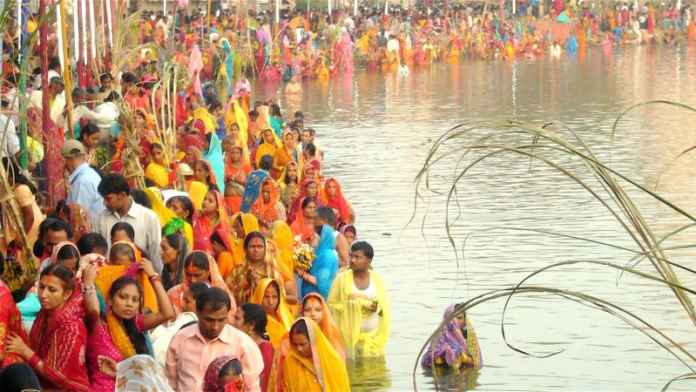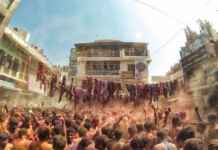The Chhath Pooja is a Vedic festival celebrated with utmost zeal in India every year in the month of Kartika. This festival is dedicated to the God of energy – Surya (Sun). It is often named as Dala Chhath or Surya Shashti. This festival is celebrated to pay gratitude to the Lord Surya for blessing the life on the earth and to seek prosperity for friends and relatives. The rituals at this day is followed by waking up early in the morning, then taking a holy bath in the river and keeping fast whole day. The fasting persons cannot even drink water; they have to stand in the water chanting the holy mantras. They offer Prasad and ardhya to the rising sun. It is celebrated nationwide, but it is a major festival of Bihar, UP, Jharkhand and Nepal. In accordance with the Hindu calendar, it is celebrated on the 6th day of the month of Kartika (month of October or November). It is named as Chhath because it is celebrated at the 6th day of the month of Kartika. It is usually observed after 6 days of Diwali.
Origin of Chhath Pooja
Chhath pooja has a great historical significant and it is said that the oldest Purohits were asked by the kings to perform the traditional pooja of Lord Surya. They used to chant the Rig-Veda hymns in order to please Lord Surya. As every Indian festival has more than one folk lore, Chhath Pooja has also more than one tale.
Story of Draupadi
It is said that Draupadi was a keen devotee of Lord Surya – the Sun god. Her extreme devotion toward Surya lead her to gain a power, she was able to cure the most deadly diseases. Draupadi possessed the energy that helped the Pandavas to regain the kingdom. Just like the energy of sun has the capability to treat all the diseases, the godly energy of Surya blessed her to heal any severe disease. As a tribute to Draupadi and the Lord Surya, the main Deity to worship on Chhath Pooja is Surya.
Story of Karna
It is supposed that the Chhath pooja was commenced for the first time by the Surya Putra Karna. He was a great warrior and had been famous for his charity. It is believed that after performing Surya Pooja he ruled over the Anga Desh during Mahabharata period which is today’s Munger district of Bihar.
Story of Lord Ram
One more saga said regarding Chhath pooja celebration is that of Lord Ram. It is said that Lord Ram and Mata Sita had kept fast and offered pooja to the Lord Sun in Shukla Paksh in the month of Kartika after returning to the Ayodhya. Soon after that, Chhath pooja is observed as an important festival in the Hindu mythology and people started celebrating it every year on the same date.
Katha of Chhath Pooja
Years ago, there was a king called Priyabrat living happily with his wife Malini. But, there was emptiness in their life as they do not have child. They decided to organize a Yagya with the help of Maharishi Kashyap. Soon after Yagya, Malini became pregnant but she gave birth to a dead child. The King went into depression and decided to suicide. Suddenly, Goddess Khashti appears before him and said that, “if somebody would perform a pooja for me with pure mind; he shall be blessed with a child.” The king Priyabrat honored the goddess by offering her pooja and got blessed with a very beautiful child. Since then, people started celebrating the Chhath pooja for the sake of their children.
Rituals and Traditions of Chhath Pooja
It is believed that worshipers who are on fast take holy bath followed by a period of isolation and get themselves separated for a period of 4 days from the main family. Right through the period he/she is treated as the chaste spirit and sleep on the ground with a single blanket. There is a conviction that once a family begins Chhath Pooja, it has to performed the coming years as well and it can only be gapped when a death of any person observed in the family that year.
Nahai Khai: First Day of Chhath Pooja
On the very first day, the devotees take an early morning bath in the river Ganges and bring some water to prepare the Prasad. Before this, the home is well cleaned and purified with gangajal. They consume only one meal a day which is known as kaddu-bhat cooked only in bronze or soil utensils using mango woods to fire over the chulha (stove made of soil).
Kharna: Second day of Chhath Pooja
On the day before Chhath, the second day, devotees fast for the entire day and worship of Sun after the sunset. They offer Kheer, puris, fruits in the pooja to Lord Surya and distribute the same to relatives also. After having the evening meal, they start fasting without water for the next 36 hours.
Sandhya Argha: Third day of Chhath Pooja
Now comes the most important day, third day is observes as Chhath Pooja. The devotees perform the Sandhya Argha at the bank of river. After Argha, they wear a single sari of yellow color. At the night, a brisk occasion is celebrated by lighting the earthen diyas and surrounds them by five sugarcane sticks. These five sticks depict Panchatattva, i.e. fire, water, earth, air and space. It is considered fortunate to get blessings of sun during the sunset.
Suryodaya Argha: Fourth day of Chhath Pooja
The devotees along with their family and friends offer Suryodaya Argha at the bank of river Ganges. After giving Suryodaya Argha devotees break their fast by tasting ginger and sugar. Children fire crackers and family members sing folk songs. These songs put in soul to the celebration.
Dates of Chhath Pooja 2015
| Date | Day | Tithi | Occassion |
| November 15 | Sunday | Chaturthi | Nahai Khai |
| November 16 | Monday | Panchami | Kharna |
| November 17 | Tuesday | Shashthi | Sandhya Argha |
| November 18 | Wednesday | Saptami | Suryodaya Argha |













